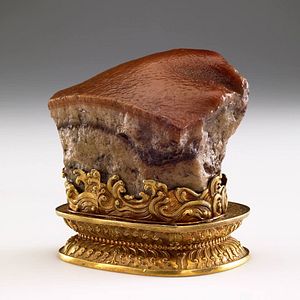Last week a seemingly minor diplomatic incident took place between the People’s Republic of China (PRC) and the state government of Australia’s New South Wales (NSW). Officials from the Chinese consulate in Sydney met with the Arts Minister from the NSW state government to formally protest an exhibition titled “Heaven and Earth in Chinese Art” currently on display at the Art Gallery of New South Wales (AGNSW). The exhibition is on loan from the National Palace Museum in Taiwan (formally known as the Republic of China). Although the Chinese officials did not ask for the exhibition to be shut down, they questioned why the gallery and the NSW state government was dealing with Taiwan.
The 87 pieces that are on display at the gallery until May 5 have a unique modern history that lend themselves to the sensitivities of the Chinese Communist Party (CCP). Initially removed from Beijing’s Palace Museum in the 1920s, the works were strategically moved around the mainland for 20 years to evade capture by invading Japanese forces. Then, as the communists gained control of the mainland in the subsequent civil war, what were considered the finest of the artworks were transported to Taiwan as the Kuomintang regime retreated to the island.
Due to the destruction of much of China’s ancient art that had remained on the mainland during Mao’s Cultural Revolution, the National Palace Museum in Taiwan is now considered the premier collection of Chinese works from the Neolithic age up through to the end of the Qing Dynasty in 1912. Therefore, for those going to view the exhibition in Sydney it is Taipei, rather than Beijing, that will be deemed to be custodian of China’s ancient artworks. The artworks symbolize a contest over who owns Chinese history, and these pieces are critical cultural assets that Beijing cannot match.
Due to fear of artworks being impounded on behalf of the PRC, Taipei remains very cautious about who it lends its collections to, making this exhibition a significant art-world coup for AGNSW. While this caution is understandable, these artworks constitute a strategic asset that Taipei seems keen to utilize in its attempt to push back against its diplomatic isolation. In this way, the lending of these works can be seen as a part of Taiwan’s New Southbound Policy (NSP). The NSP has also sought to converge with the free and open Indo-Pacific strategies of Japan and the United States, which Taipei sees as essential to resisting the unifying pressures of the PRC.
The New Southbound Policy, launched in 2016, aims to improve Taiwanese cooperation and exchange with the ASEAN countries, South Asia, and Australia and New Zealand, with the goal of reducing economic dependence on the PRC. Despite Taiwan’s lack of diplomatic recognition, the policy also seeks to harness greater sympathy for Taiwan throughout these regions to work as a counterforce to Beijing’s increasingly assertive attempts to incorporate the island. This cultural exchange can be viewed as an essential part of what Taiwan’s foreign minister, Joseph Wu, articulated in a speech to the Global Taiwan Institute in September as the country’s “warm power” — a power that “radiates integrity, substance, and genuine care,“ which he contrasted with the “sting” of China’s “sharp power.”
Delicious cooperation! #Taiwan & #Australia are like-minded countries enjoying exchanges across an array of areas such as culture, education, tourism & trade. We look forward to working even closer with the #NewSouthboundPolicy & #IndoPacific nation in taking ties to new heights. https://t.co/R0cbXvlus8
— 外交部 Ministry of Foreign Affairs, ROC (Taiwan) 🇹🇼 (@MOFA_Taiwan) February 11, 2019
For Australia, although it is limited in its ability to interact diplomatically with Taiwan, cultural exchanges like the exhibition at AGNSW form a key component of the de facto relationship between the two. These cultural links are more difficult to pin down, particularly in liberal democracies where the state cannot disrupt people-to-people exchanges, or sanitize what art, music, or film people consume. If Taipei is looking to reach out toward Australia there is little Canberra, or indeed Beijing, can do to prevent Australians from accepting the gesture.
Australia has made a bold strategic calculation between its desire to interact freely with a like-minded liberal democracy and the clear geostrategic pitfalls of upsetting Beijing. There is no doubt that the implications of hosting the “Heaven and Earth in Chinese Art” exhibition would have been discussed by both the New South Wales government and the federal government, and a decision was made knowing that Beijing would protest. A degree of push-back against Beijing’s sensitivities is factored into the exhibit.
State institutions like art galleries blur the lines between civil society and state-level interactions, and this, in its own messy way, is consistent with the strategic ambiguity of Australia’s One China policy (a noted distinction from the PRC’s One China principle). The broader definition of what constitutes the entity of “China” is therefore on display in Sydney for the next few months in more ways than one.

































